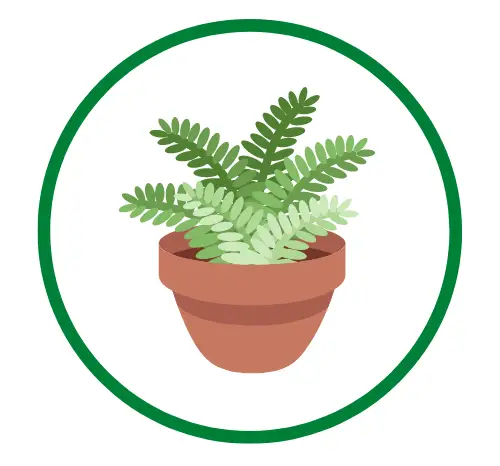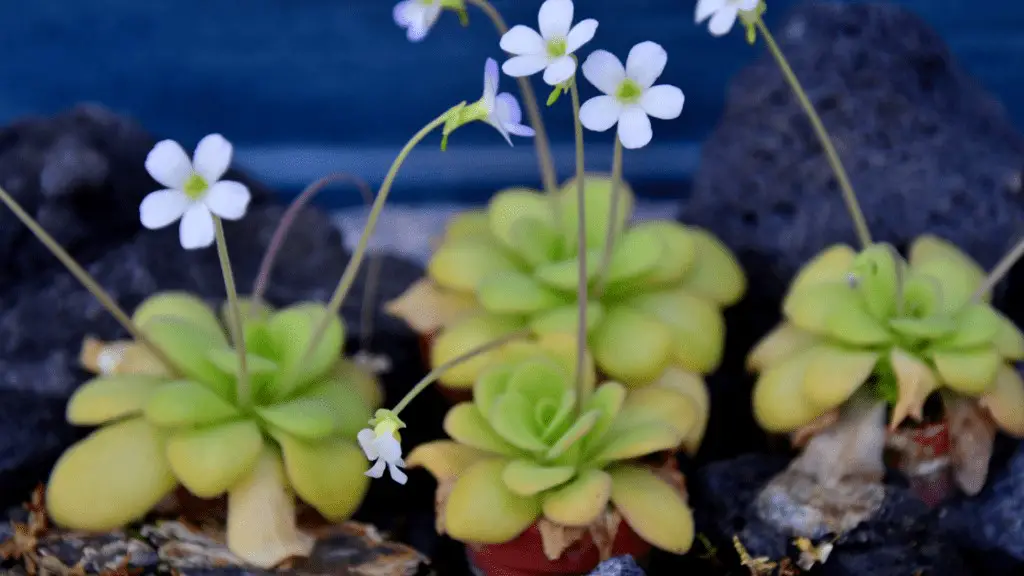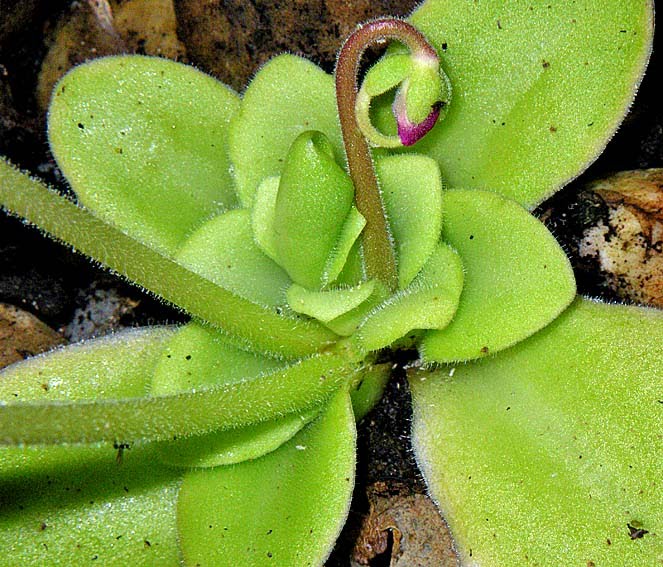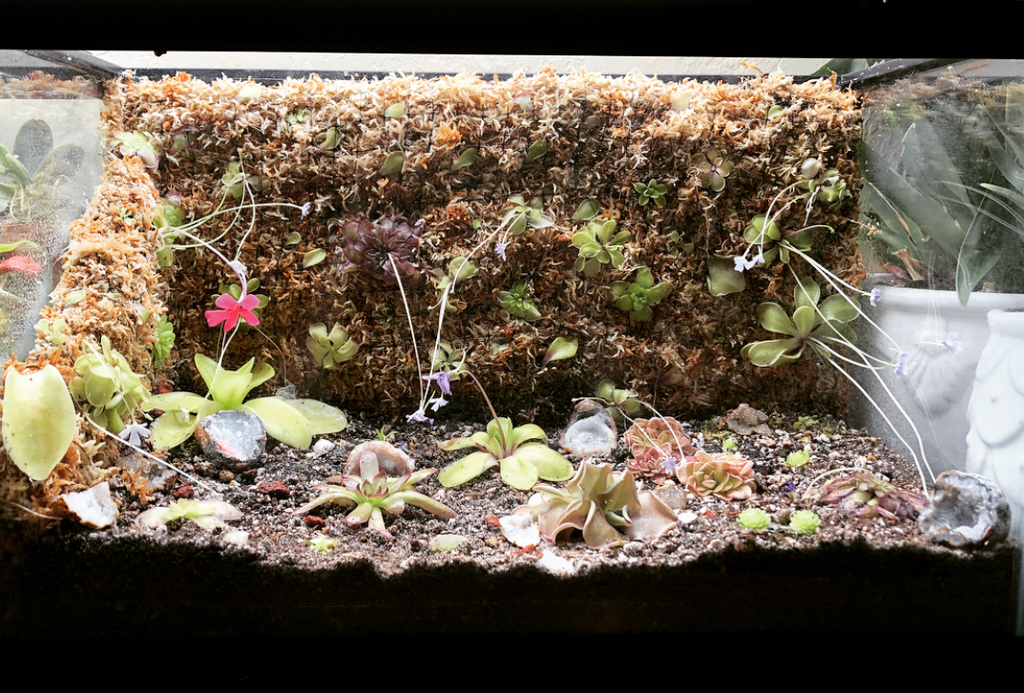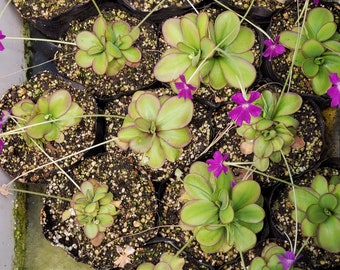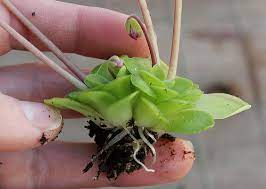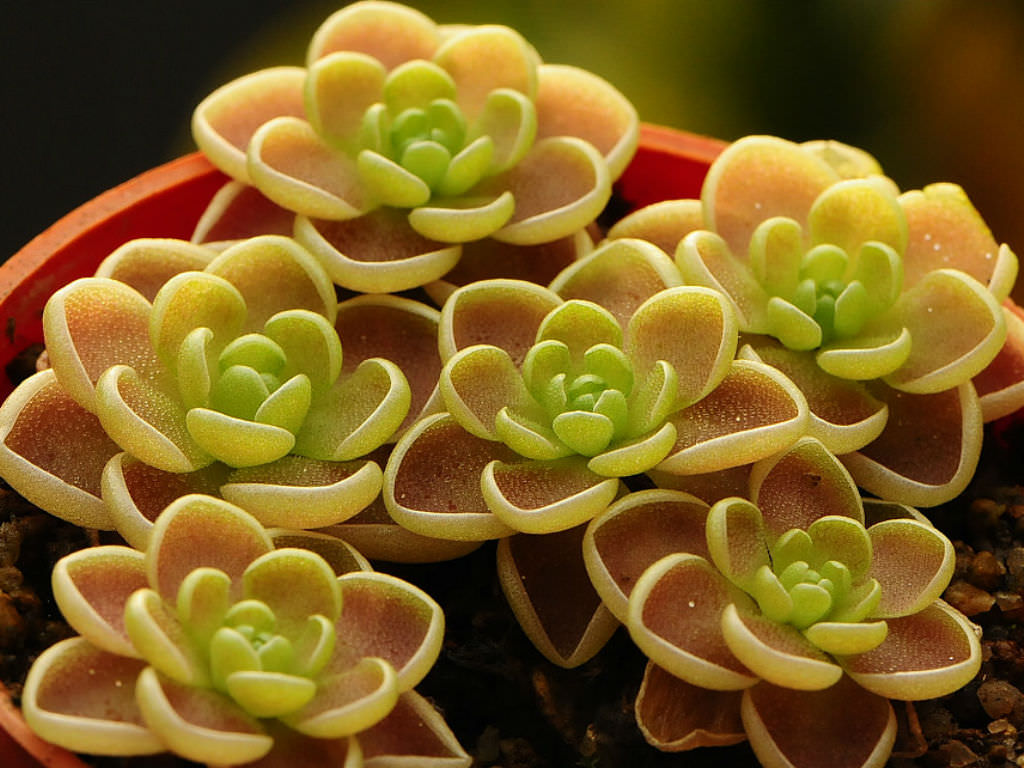Mexican Butterwort Plant – Pinguicula
Butterworts are to carnivorous plants what flypaper is to insects. Its scientific name, Pinguicula, translates to “little greasy one” in Latin and is commonly referred to as “pings.” It derives from their large, emerald-green leaves, which are coated in tiny glands that exude a greasy-feeling mucilage. As a result of these mucilage drips, the leaves glisten in the light, luring hungry insects.
Most are rather simple to grow and can be excellent choices for windowsill planting. Different known species of butterwort differ somewhat from one another. For instance, some plants grow leaves with a crimson hue in locations with a lot of sunlight. When they capture insect, other species’ leaves curl.
If you offer them with sufficient light and clean water (with a low salt/mineral content of less than 20 ppms), they are a simple carnivorous plant to nurture. As an added bonus, if they are content, they may flowers once or twice a year.
Regarding Pinguiculas/Pings
Pings originate in Mexico and Central America, where they are found growing on exposed outcrops and moss-covered limestone rocks. Despite what you may have read, many known species can flourish at lower humidity (as long as you keep their roots continuously moist and prevent extreme desiccation/drying out).
They easy to grow in high humidity and relatively strong light. Many of the species have separate development and dormancy cycles because their natural habitat has an annual wet and dry season, but I have discovered that regardless of the season, they receive the same care.
Butterwort Сarnivorous Plant Care – Growing Pings Terrariums
Mexican butterwort thrives in grow rooms with fluorescent or LED lighting. Consider the conditions of winter dormancy. In terrariums, some Pinguicula thrive that are temperate. Temperates in terrariums should be avoided—total problem.
Butterwort Сarnivorous Plant Care – Growing Pings Outdoors
The type of species you’re cultivating and whether your climate is compatible with their natural settings will determine how successfully you can produce butterwort outdoors. It is best to bring some Mexican species indoors and position them on windowsills during dormancy because they require drier winter conditions.
Butterwort Сarnivorous Plant Care – Growing Pings as Houseplants
There are a few options for potting material in the Pinguicula:
Perlite and peat moss combined (or sand)
Almost a 50/50 split. When utilizing a peatmoss blend, the plants can be watered often; nevertheless, the peatmoss should never be allowed to go completely dry.
Pure Sphagnum
I’ve even observed individuals using nothing but sphagnum moss (though this may stay too wet or too acidic for some species of ping). The pot can be placed in a shallow tray of water, but it should be allowed to dry out for a brief time every 3 to 4 weeks to ensure that the root zone is oxygenated.
The roots and plant stay moist for a longer period of time with the peatmoss and sphagnum alternatives since those media hold more water than rock; this may be a preferable option for farmers in arid locations.
Planting mix for orchids
Bark, pumice, and perlite mixed together in the bottom half of the container, with sphagnum moss on top. If choosing the rock or orchid bark alternatives, the pots can remain submerged in a shallow tray of water continuously.
“Ping Pot” for a “Natural Look” with Live Moss and a Rock-Blend
The grower can construct a natural scape that resembles the area where the pings naturally grow by utilizing stones such as turface, limestone, granite, pumice, and perlite. With the correct conditions, live moss may be planted using tweezers and should grow with the pings. Pings can be set either on the live moss or right on the rock.
Note: To keep the pebbles moist, the pot must always be submerged in a tray of water. You may also need to be extra rigorous about providing high humidity (at least 50%). Rock will quickly dry out, and if it becomes too dry, the plant may suffer.
Roots
Pinguicula species have relatively underdeveloped root systems. The plant’s slender, white roots primarily act as an anchor and a moisture absorber (nutrients are absorbed through carnivory). When the hibernaculum is produced in temperate species, these roots wither (with the exception of P. alpina). The root of the rare epiphytic species, like P. lignicola, create anchoring suction cups.
Pinguicula Carnivorous Plant Humidity
According to several websites, pings require high humidity, thus providing high humidity is generally preferable—provided you also supply excellent ventilation. However, leaf and root rot is frequently brought on by high humidity and stagnant circumstances.
Even though I have a lot of plants, my home has terrible humidity (an average of 18–45%); yet, most of the pings I’ve attempted growing have thrived. Low humidity isn’t a problem, in my experience, as long as you give the plants enough light and keep their roots moist.
My opinion is that humidity actually isn’t a big deal—as long as you don’t allow the plants dry out too much. I have even produced tiny species pings and seedlings in my low humidity. The fact that live moss tends to outgrow small species has been the largest problem I’ve encountered with cultivating pings in general.
Pinguicula Carnivorous Plants Water Quality & Watering
Some Butterworts Need Calcium & Alkalinity Even in “Pure Water”
Limestone settings are the home to some Mexican pinguicula species, usually the smaller varieties. Calcium carbonate makes up the alkaline rock known as limestone (CaCO3). If their water is too pure and they can’t get some calcium, certain pings seem to suffer. They must have relied somewhat on the calcium to grow successfully due to their adaption to thrive in soils with high calcium content, I believe.
If you have noticed that your pings don’t seem to grow well, you may wish to add a little amount of oyster shell or eggshells to your potting mix to fix the problem. Less than 1/16th of a teaspoon in a small pot is really all you need; just a tiny coating to help provide some extra calcium. Use of distilled or bottled water should continue.
To be clear, I don’t put limestone or eggshells in the pots of my plants. Instead, I add around 1/4 tap water to bottled water 2-3 times each year, which provides the calcium I think the plants need. I advise doing it because oyster shells and eggshells are frequent amendments with orchids from limestone locations (such phrag kovachii).
Avoid using tap water
Like the majority of carnivorous plants, pings thrive in clean water that won’t damage the roots or evaporate too quickly. If your water contains a lot of minerals, the salts in it may accumulate over time when you water and the water evaporates, which may cause problems that pings are unable to remedy.
I use Aquafina or SmartWater bottled water for my plants, but you can use any brand that contains fewer than 20 ppms. As near to zero as you can get is desirable. Water bottles often list the total ppms, which stands for parts per million or 1 mg per 1L of water. It will also function with distilled or RO water because it is mineral-free and pure.
Avoid misting the rosettes from above
Or, better yet, refrain from spraying leaves with water that has gathered on them. It IS possible, and I’ve used it a few times to clean leaves that had accumulated a lot of dead gnats. However, if water pools and remains in the rosette, smaller plants are more likely to get leaf and crown rot, and every time I’ve given a “top-down shower,” I’ve lost at least one or two little seedlings.
Instead, water from the bottom or around the rosettes using a water bottle with a single hole melted into the cap. This will allow you to moisten the area surrounding the plant without wetting the leaves completely.
Needs for Light in Pinguicula Carnivorous Leaves
Light that is somewhat bright is ideal for pings. In the early or late hours of the day, close to an East or West window where they receive direct sunlight. Midday direct sun may be too hot and could burn the foliage.
Additionally, they perform admirably when grown under LED grow lights, where the level of light is more constant throughout the day. If you’re utilizing LED lights, choose 18 to 24 watts of LED light per square foot, spaced 12 inches apart. If the plants are near the light, use a lower wattage (12–18w), and if they are farther away, choose a greater wattage because dispersion will reduce the intensity of the light.
Changes in Butterwort Leaf Seasonality
Pings can be seasonal, and based on the kind you have, they might experience seasonal changes that are triggered by the photoperiod (how long the daylight hours are). The succulent leaves may get smaller and more succulent during the winter when the days are a little bit shorter and chilly (and they may stop catching bugs).
The carnivorous leaves will grow bigger, fuller, and create more dew for collecting insects in the summer when the days are longer. It’s a good idea to gradually change your light hours if you’re growing inside with artificial lighting to account for seasonal variance (on for 10h in the winter and on for 14h in the summer). Your plant will be better able to follow its circadian rhythm and seasonal variations if you do this.
Some people reduce watering during dormancy; I don’t because my humidity is already so low and going completely dry runs the risk of killing the plant if the little roots are damaged (which keep the plant hydrated). The pot rests in a shallow tray of water that I fill every week or two, and as I indicated above, I treat them the same all year round.
Feeding and Fertilizing Carnivorous Pings
Use insects as fertilizer instead of chemical ones. You’re lucky if you don’t have a fungus gnat issue, as I obviously have. Generally speaking, you can get away with without feeding your plant because the majority of its “food” comes from light. Pings are ideal friends for individuals who already have a lot of plants because they eat little soil insects (like mites, springtails, etc.) and things that are naturally present in your pots.
The majority of their prey are insects with wings and the ability to fly, making up a variety of species in the arthropod taxon that make up their diet. The earliest steps in the feeding process for carnivorous plants involve attracting, holding onto, and grabbing prey; the process’s outcome is the absorption and digesting of nutrients from various food sources.
Pinguicula species passively gather their prey using sticky, adhesive leaves, therefore they do not actively choose their meal. However, their beautiful leaves do have the capacity to draw attention, which will boost the chances of luring and capturing a certain species.
Propagating Butterworts
Butterworts can be multiplied in three different ways: by vegetative cloning via “leaf pullings,” by division, or by seed. All three are rather simple to perform; however, leaf pullings develop a little more quickly than seedlings, and plant divisions should only be made in the late spring, after the plants have finished flowering and naturally divided into numerous new rosettes. Be careful that plants grown from seeds will be more variable than plants grown from cloned leaf pullings (which would be identical to the parent plant they came from).
Dividing Butterworts
Pings will flower in the spring when they are well-established and content, and the rosette will frequently divide into two or more new rosettes at the same time due to the new buds.
You may easily unpot and divide the rosettes once flowering is finished and they begin to produce their own set of leaves. I’ve learned the hard way that if you do this too early, you could completely destroy a rosette by pulling all the leaves off of it.
If the pup is big enough, it can be preferable to cut it from the primary mother with a sharp knife. These offspring will be exact replicas of the parent plant, just like your original butterwort.
Ping Clones from Leaf Pullings
This procedure is exactly the same as when you use leaf pullings to propagate succulent. The end of their dormancy, just before or as new leaves are being created for the growth season, is the perfect moment to take a leaf pulling from your ping. The leaves will be juicy and simple to separate. Having said that, you should be able to take pullings at any time of year provided your plant is healthy and established.
Pinguicula Seed Growing
When having a leaf-pulling is not an option, you may need to buy seeds or try growing seedlings from your own plants instead. With the exception of a few special care changes you’ll need to make because the plants are so tiny, growing pings from seed is a little more difficult but generally similar to growing the adults.
Butterwort Species
Popular Ping Types
-
Pinguicula moranensis ‘G’
-
Pinguicula agnata ‘True Blue’
-
Pinguicula gigantea
Popular Mini or Mexican Pings
-
Pinguicula laueana
-
Pinguicula ehlersiae
-
Pinguicula esseriana
-
Pinguicula jaumavensis
-
Pinguicula immaculata
Where to look for wild butterworts
Nearly 100 different Pinguicula species exist and thrive in a variety of environments worldwide. From the Arctic Circle through Siberia, Europe, and North America, home stretches. The most abundant and impressive species can be found in Mexico. Several species persist all the way to South America and very rarely Central America.
